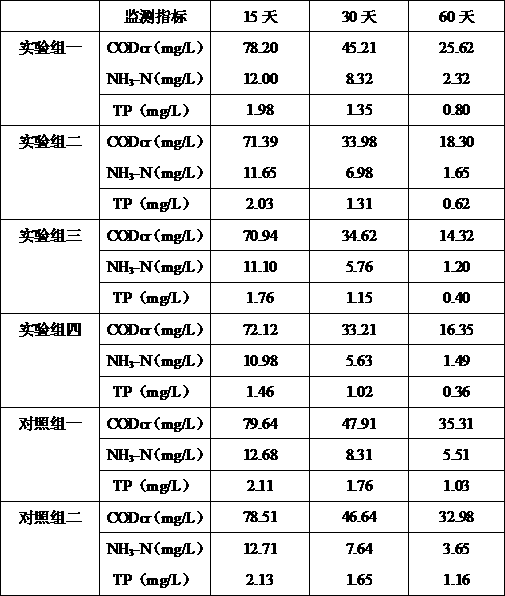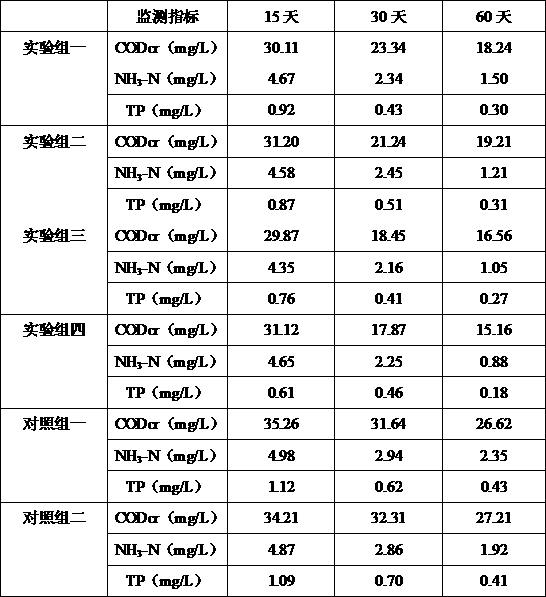Method for repairing polluted water body by using immobilized composite microorganism technology
A technology of compound microorganisms and microorganisms, which is applied in the field of microbial remediation of polluted water bodies, can solve problems such as uneven remediation effects, and achieve the effects of maintaining functional microbial activity, strong adaptability and low cost.
- Summary
- Abstract
- Description
- Claims
- Application Information
AI Technical Summary
Problems solved by technology
Method used
Image
Examples
Embodiment 1
[0031] A method for repairing polluted water bodies with immobilized composite microorganism technology. The microorganisms with remedial effects separated from the polluted water bodies to be repaired are mixed with functional strains and then immobilized, and then the immobilized composite microorganisms are put into the water to be repaired. Restoration is carried out in the repaired water body; functional strains include photosynthetic bacteria, yeast, Bacillus megaterium, lactic acid bacteria, and iron bacteria. parts, iron bacteria 10 parts.
[0032] In this example, the remedial microorganisms isolated from the polluted water body to be repaired include nitrifying bacteria, denitrifying bacteria and Bacillus subtilis, which are screened through the following steps: (1) Nitrifying bacteria, the enrichment screening method is : Take 1mL of polluted water samples into a Erlenmeyer flask containing 99mL of sterilized nitrifying bacteria enrichment medium, shake at a constan...
Embodiment 2
[0045] A method for repairing polluted water bodies with immobilized composite microorganism technology. The microorganisms with remedial effects separated from the polluted water bodies to be repaired are mixed with functional strains and then immobilized, and then the immobilized composite microorganisms are put into the water to be repaired. Restoration in the repaired water body; functional strains include photosynthetic bacteria, yeast, Bacillus megaterium, lactic acid bacteria, iron bacteria, the ratio of the functional strains is as follows: 20 parts of photosynthetic bacteria, 35 parts of yeast, 20 parts of Bacillus megaterium, 20 parts of lactic acid parts, iron bacteria 15 parts.
[0046] In this example, the remedial microorganisms isolated from the polluted water body to be repaired include nitrifying bacteria, denitrifying bacteria and Bacillus subtilis, which are screened through the following steps: (1) Nitrifying bacteria, the enrichment screening method is : T...
Embodiment 3
[0059] A method for repairing polluted water bodies with immobilized composite microorganism technology. The microorganisms with remedial effects separated from the polluted water bodies to be repaired are mixed with functional strains and then immobilized, and then the immobilized composite microorganisms are put into the water to be repaired. Restoration is carried out in the water body; the functional strains include photosynthetic bacteria, yeast, Bacillus megaterium, lactic acid bacteria, and iron bacteria. 10 parts, 10 parts of iron bacteria.
[0060] In this example, the remedial microorganisms isolated from the polluted water body to be repaired include nitrifying bacteria, denitrifying bacteria and Bacillus subtilis, which are screened through the following steps: (1) Nitrifying bacteria, the enrichment screening method is : Take 1mL of polluted water samples into a Erlenmeyer flask containing 99mL of sterilized nitrifying bacteria enrichment medium, shake at a consta...
PUM
 Login to View More
Login to View More Abstract
Description
Claims
Application Information
 Login to View More
Login to View More - R&D
- Intellectual Property
- Life Sciences
- Materials
- Tech Scout
- Unparalleled Data Quality
- Higher Quality Content
- 60% Fewer Hallucinations
Browse by: Latest US Patents, China's latest patents, Technical Efficacy Thesaurus, Application Domain, Technology Topic, Popular Technical Reports.
© 2025 PatSnap. All rights reserved.Legal|Privacy policy|Modern Slavery Act Transparency Statement|Sitemap|About US| Contact US: help@patsnap.com


